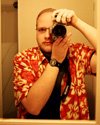It looks like the past four month's work may have just gone down the proverbial shitter.
I've been scanning some of my older work and noticing really harsh grain and had been blaming the film (I was using a different film then, a store brand, but still). So anyway, playing a hunch, I turn off all sharpening in the Nikon program and boom, problem solved. So now I have to go back and rescan, at the least, the six to eight other rolls of this particular film that I had scanned with preliminary sharpening done in the scanning program.
But here's the rub, if the "bad" film scans better without the sharpening what about the "good" Fujifilm I've been using for the past 18 months (giver or take). Am I going to have to rescan the 15 to 20 rolls of Fuji Superia I've shot (not to mention the editing of all these rescans). The answer is yes, because as much of a pain in the ass as it's going to be, I am an anal prick when it comes to image quality (which happens to be the second biggest reason that only going after a 13 inch printer, I'd rather make a superb 12x18 than a mediocre 20x30).
Now to go and bang my head against that brick wall I've building for the past four months.
*note: I think it only fair to mention that the problem has much more to do with me than it does with the Nikon Scan program. My understanding of unsharp masking comes from my experience with Photoshop, in which the "radius" of the unsharp mask is expressed in pixels, while in Nikon Scan that same "radius" is expressed as a %. I also have no doubt that there are other differences in the way in which the two programs handle USM procedures and effects. Add my inexperience with film scanning itself, specifically just what a 20 mega-pixel scan of film X should look like on a computer screen at 100% magnification, and, well...
Labels: human stupidity



0 Comments:
Post a Comment
<< Home